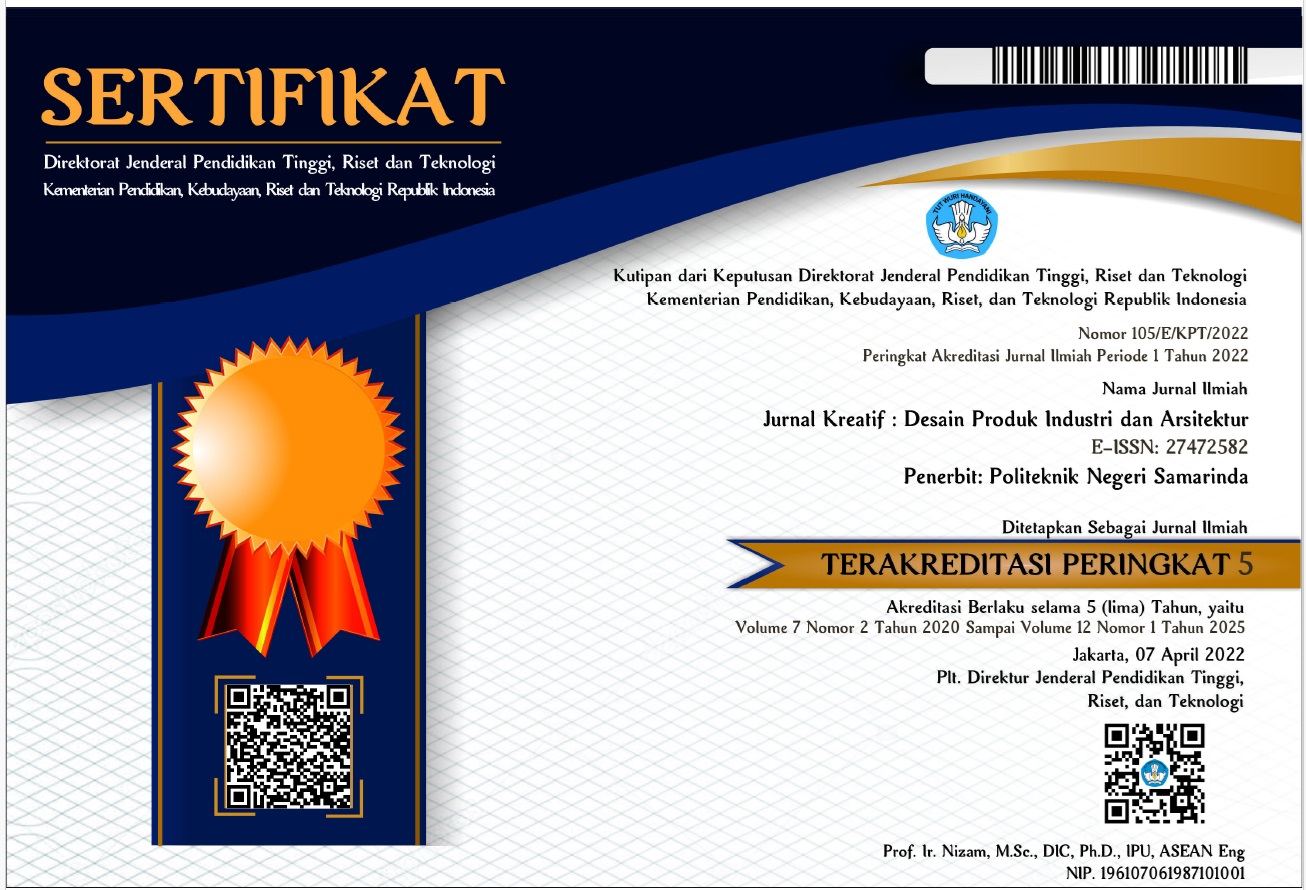CONTEXTUAL DESIGN: PENDEKATAN KEARIFAN LOKAL DALAM KONSEP PERANCANGAN DIGITAL START-UP VALLEY PIYUNGAN, YOGYAKARTA
 Abstract views: 409
,
Abstract views: 409
,
 PDF downloads: 493
PDF downloads: 493
Abstract
This article discusses how the contextual approach of local wisdom values can be considered in determining project design concepts. In this case the concept of digital start-up valley Piyungan applies the contextual division of zones into 3 parts that follow the pattern of the existing space in the location, namely the Education Zone, namely the public zone for Campus IT education. The second zone is a digital park area which is bounded by natural tributaries on a maintained site to give a recreational impression. And the third zone which is in the most private area is designated as the digital office area as the digital start-up valley office location. This article is the result of an exploration of design concepts that produce a conceptual approach that is also embodied in applying the concept of campus digital modern learning activities which are accommodated in traditional building concepts that adopt local wisdom principles from the local culture
Artikel ini membahas bagaimana pendekatan kontekstual dari nilai-nilai kearifan lokal dapat dipertimbangkan dalam menetukan konsep perancangan proyek. Dalam hal ini konsep digital start-up valley Piyungan mengaplikasikan kontekstual pembagian zona dalam 3 bagian yang mengikuti pola ruang eksisting yang telah ada dilokasi yaitu Zona edukasi yakni zona publik untuk pendidikan IT Campus. Zona kedua berupa area digital park yang dibatasi oleh anak sungai alami pada tapak yang dipertahankan untuk memberi kesan rekreatif. Dan zona ketiga yang berada pada area paling privat diperuntukan sebagai area digital office sebagai lokasi perkantoran digital start-up valley. Artikel ini merupakan hasil eksplorasi konsep desain yang menghasilkan pendekatan konseptual juga diwujudkan dalam mengaplikasikan konsep kegiatan pembelajaran modern digital kampus yang diakomodasi dalam konsep bangunan tradisional yang mengadopsi prinsip-prinsip kearifal lokal dari budaya setempat..
Downloads
References
Abrar, N. (2022). Contextuality and Design Approaches in Architecture: Methods to Design in a Significant Context. International Journal of Education & Social Sciences (IJESS), 2(11).
Aranda-Jan, C. B., Jagtap, S., & Moultrie, J. (2016). Towards a framework for holistic contextual design for low-resource settings. International Journal of Design, 10(3), 43–63. https://doi.org/10.17863/CAM.7254
Boro, H. M., Setyabudi, I., & Alfian, R. (2022). Analisis Programatik Lanskap Pasar Rakyat Karangploso dengan Pendekatan Arsitektur Kontekstual. Aksen, 6(2), 16–29. https://doi.org/10.37715/aksen.v6i2.2355
Gomoll, A., Tolar, E., Hmelo-Silver, C. E., & Šabanović, S. (2018). Designing human-centered robots: The role of constructive failure. Thinking Skills and Creativity, 30(March), 90–102. https://doi.org/10.1016/j.tsc.2018.03.001
Hadgraft;, G. G., & Kolmos, A. (2020). Aalborg Universitet Emerging learning environments in engineering education This is an Accepted Manuscript of an article Published by Taylor & Francis in Australasian Journal of Engineering Education available online : Australasian Journal of Engineering Education, 25(1).
Halimia, A., & Nuffida, N. E. (2022). Social Sustainability sebagai Pendekatan Rancangan Kontekstual Ruang Publik di Pamekasan. Jurnal Sains Dan Seni ITS, 10(2), 2–7. https://doi.org/10.12962/j23373520.v10i2.71213
Hettithanthri, U., Hansen, P., & Munasinghe, H. (2022). Exploring the architectural design process assisted in conventional design studio: a systematic literature review. International Journal of Technology and Design Education, 0123456789. https://doi.org/10.1007/s10798-022-09792-9
International Council for Science. (2017). A Guide To SDG Interactions : From Science. In International Council for Science (Vol. 33, Issue 7). https://www.modares.ac.ir/uploads/Agr.Oth.Lib.17.pdf
Lambe, N., & Dongre, A. (2016). Contextualism : An Approach To Achieve Architectural Identity And Continuity. International Journal of Innovative Research and Advanced Studies(IJIRAS), 3(2), 33–42.
Liauw, F. (2019). Reference for contextual design. IOP Conference Series: Materials Science and Engineering, 508(1). https://doi.org/10.1088/1757-899X/508/1/012031
Löffler, D., Wallmann-Sperlich, B., Wan, J., Knött, J., Vogel, A., & Hurtienne, J. (2015). Office Ergonomics Driven by Contextual Design. Ergonomics in Design, 23(3), 31–35. https://doi.org/10.1177/1064804615585409
Machado, L., & Pacheco, A. (2019). An approach to the Contextual Design methodology in the context of Information. 4o Congreso ISKO (España-Portugal), 2019, 57–68. https://doi.org/10.5281/zenodo.3733526
Sahin, M., Dervishi, S., Ozbil, A., & Tekce, I. (2016). Changing Context of Contextual Design Studio. Design Communication European Conference 23, 1.
Widati, T. (2015). Pendekatan Kontekstual dalam Arsitektur Frank Lloyd Wright. Jurnal Perspektif Arsitektur, 10(1), 38–44. https://e-journal.upr.ac.id/index.php/JTA/article/view/857/696
Copyright (c) 2023 Ahmad Ibrahim Rahmani

This work is licensed under a Creative Commons Attribution-ShareAlike 4.0 International License.
Authors who publish with this journal agree to the following terms:
- Copyright on any article is retained by the author(s).
- The author grants the journal, right of first publication with the work simultaneously licensed under a Creative Commons Attribution License that allows others to share the work with an acknowledgment of the work’s authorship and initial publication in this journal.
- Authors are able to enter into separate, additional contractual arrangements for the non-exclusive distribution of the journal’s published version of the work (e.g., post it to an institutional repository or publish it in a book), with an acknowledgment of its initial publication in this journal.
- Authors are permitted and encouraged to post their work online (e.g., in institutional repositories or on their website) prior to and during the submission process, as it can lead to productive exchanges, as well as earlier and greater citation of published work.
- The article and any associated published material is distributed under the Creative Commons Attribution-ShareAlike 4.0 International License













